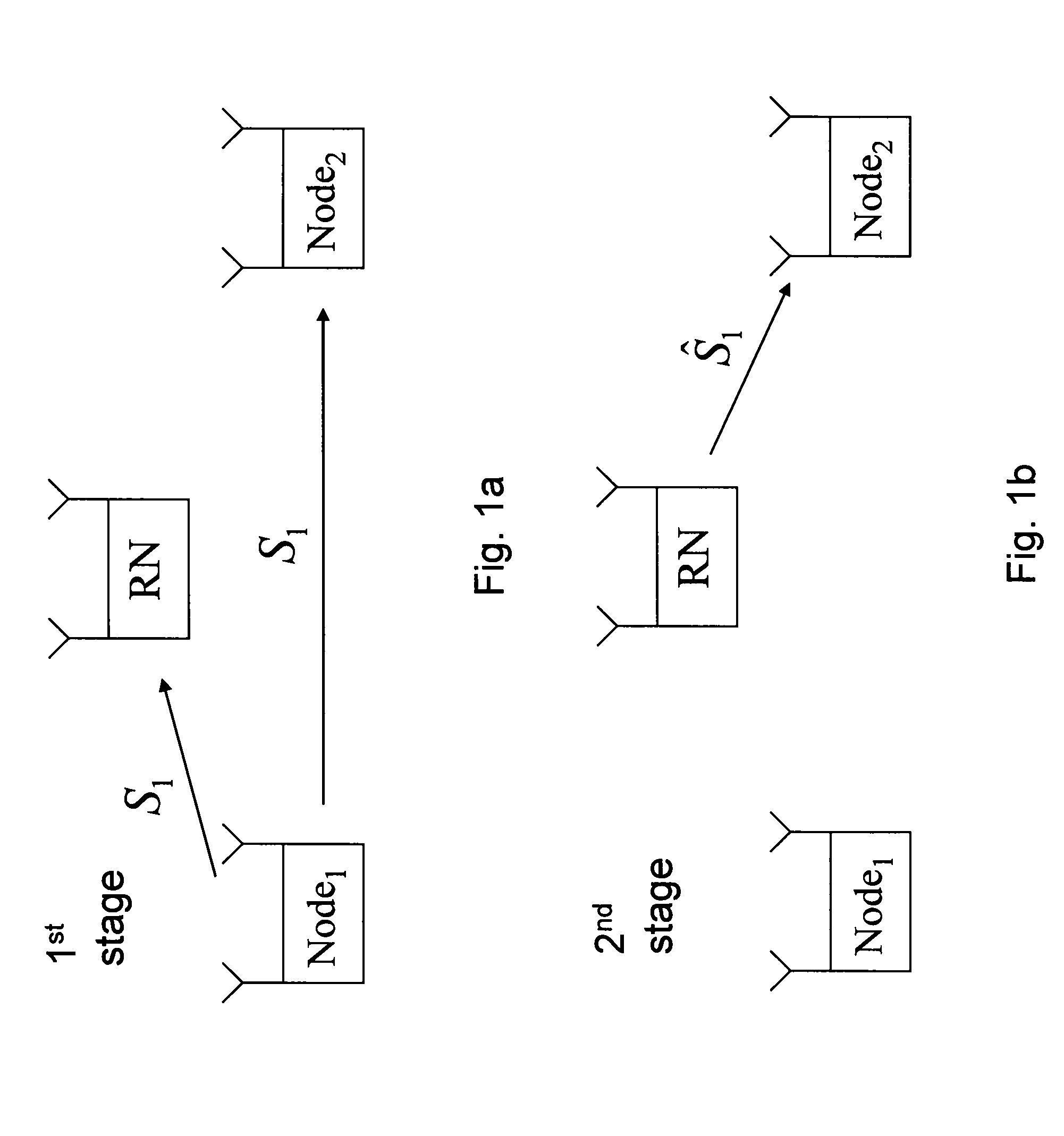Multiple-in-multiple-out antenna network-coded amplify-and-forward relaying scheme for three node bidirectional cooperation
a multi-in-multi-out antenna and bidirectional cooperation technology, applied in repeater/relay circuits, site diversity, transmission monitoring, etc., can solve problems such as the suffering of transmission between two nodes, and achieve high throughput (vht)
- Summary
- Abstract
- Description
- Claims
- Application Information
AI Technical Summary
Benefits of technology
Problems solved by technology
Method used
Image
Examples
case 2
[0044]General When α1 and β2 exist, {tilde over (W)}1 is an identity matrix multiplied by a constant, i.e., {tilde over (W)}1=λ1ILR, λ1≧0; while {tilde over (W)}2=Λ21 / 2=diag{λ2, 11 / 2, . . . , λ2, LR1 / 2}. λ2, i≧0, i=1, . . . , LR, is a diagonal matrix. The notation in the iterative approach is as follows:
λ=(λ1,λ2,1,…,λ2,LR)T,max_λ=(PRdaσn2,PRcb,1σn2,L,PRcb,Mσn2,1LR-MT)T,μ=(μ1,L,μL2(L2-1)+1)T,vk=(vλ1k,vλ2,1k,L,vλ2,LRk,vμ1k,L,vμL2(L2-1)+1k)T,1N=(1,…,1N).S=[0L2(L2-1)×1S2dacb,1,L,cb,M,01×(LR-M)],q=(0L2(L2-1)×1PRσn2),whereca,i=P1L1σn2λR1,i+1,cb,i=P2L2σn2λR2,i+1,i=1,L,M,da=∑i=1Mca,i,andM=min(L1,L2,LR).
[0045]And
S2=[Re{s2}Im{s2}]∈RL2(L2-1)×LR,
where Re{•} and Im{•} are the functions which take the real and imaginary parts of the variables, and s2 comes from the linear equations
∑k=1LRλ2,ktki*tkj=0,1≤i<j≤L2,i.e.,s2=(t11*t12t21*t22LtLR,1*tLR,2t11*t13t21*t23LtLR,1*tLR,3MMOMt11*t1,L2t21*t2,L2LtLR,1*tLR,L2t12*t13t22*t23LtLR,2*tLR,3MMOMt12*t1,L2t22*t2,L2LtLR,2*tLR,L2MMOMt1,L2-1*t1,L2t2,L2-1*t2,L...
case 3
[0046]General When β1 and β2 exist, both W1%=Λ11 / 2=diag{λ1, 11 / 2}. λ1, i≧0, i=1, L, LR, and W2%=Λ21 / 2=diag{λ2, 11 / 2, L, λ2, LR1 / 2}, λ2, i≧0, i=1, L, LR, are diagonal matrices. The notation in the iterative approach is as follows:
λ=(λ1,1,Lλ1,NR,λ2,1,Lλ2,LR)T,μ=(μ1,L,μL2(L2-1)+1)T,max_λ=(PRca,1σn2,L,PRca,Mσn2,1LR-MT,PRcb,1σn2,L,PRcb,Mσn2,1LR-MT)T,1N=(1,…N,1),andvk=(vλ1,1k,L,vλ1,LRk,vλ2,1k,L,vλ2,LRk,vμ1k,L,vμL2(L2-1)+1k)T.S= [S10L1(L1-1)×10L2(L2-1)×1S2ca,1,L,ca,M,01×(LR-M)cb,1,L,cb,M,01×(LR-M)],q=(0[L1(L1-1)+L2(L2-1)]×1PRσn2),whereca,i=P1L1σn2λR1,i+1,cb,i=P2L2σn2λR2,i+1,i=1,L,M,andM=min(L1,L2,LR).
And
[0047]S1=[Re{s1}Im{s1}]∈RL1(L1-1)×LRandS2=[Re{s2}Im{s2}]∈RL2(L2-1)×LR,
where Re{•} and Im{•} are the functions which take the real and imaginary part of the variables, s1 and s2 come from the linear equations
∑k=1LRλ1,ktiktjk*=0,1≤i<j≤L1,and∑k=1LRλ2,ktki*tkj=0,1≤i<j≤L2,
respectively, i.e.,
s1=(t11t21*t12t22*Lt1,LRt2,LR*t11t31*t12t32*Lt1,LRt3,LR*MMOMt11tL1,1*t12tL1,2*Lt1,LRtL1,LR*t21t31*...
PUM
 Login to View More
Login to View More Abstract
Description
Claims
Application Information
 Login to View More
Login to View More - R&D
- Intellectual Property
- Life Sciences
- Materials
- Tech Scout
- Unparalleled Data Quality
- Higher Quality Content
- 60% Fewer Hallucinations
Browse by: Latest US Patents, China's latest patents, Technical Efficacy Thesaurus, Application Domain, Technology Topic, Popular Technical Reports.
© 2025 PatSnap. All rights reserved.Legal|Privacy policy|Modern Slavery Act Transparency Statement|Sitemap|About US| Contact US: help@patsnap.com



